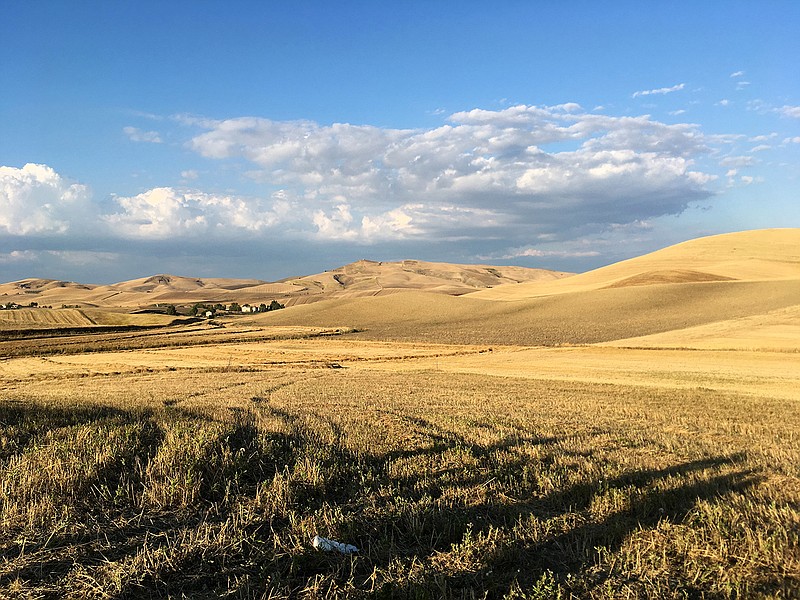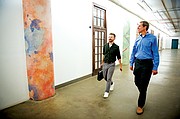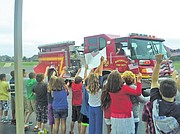"I
s it OK," I asked, "to put my hand here?"
"Here" was Jesus' brown hair, on a 700-year-old fresco of the crucifixion, in a cave church in Puglia, Italy. In the fresco, Jesus' eyes were depicted as closed, giving the portrait an oddly serene feel. My task at the moment was to use a scalpel to scrape away calcium deposits on the right eye (a spider was sitting on the left one), and I needed to ground my hand on the fresco to get good leverage.
Tonio Creanza glanced over from the fresco he was working on. "Sure," he said.
So I started scraping.
That someone like me-well-meaning but completely untrained and unskilled-would be applying a razor-sharp instrument to an ancient treasure is due, entirely, to Creanza, a 50-year-old George Clooney look-alike who hails from the Puglian town of Altamura. In 1989 he launched a summer workshop designed to bring in volunteers to work on preserving and celebrating some of the treasures of his native region.
The idea has grown over the years. Today, Messors-the organization he runs with his wife, Canadian-born Jennifer Bell-offers several workshops over the course of each summer. In three of them, the emphasis is on preserving and restoring ancient frescoes and Renaissance paintings; in the other, participants repair shepherds' fences, make pecorino cheese from the milk of the sheep and learn to bake the characteristically yellow-hued local bread.
My wife, Gigi, a committed Italophile, had always harbored a dream of doing art-restoration work in her favorite country, and landed on the Messors website while looking around for a way to do so. She was enthusiastic, I was game, and so one day late in June we found ourselves on a four-hour bus ride from Naples southeast to Altamura. Tonio's university-student nephew, Marco, picked us up on the side of the road and drove us the short distance to Messors's rented "palazzo"-essentially, a very large four-story townhouse in the middle of the nearby town of Gravina in Puglia, population approximately 44,000.
We and the other 12 participants-from the United States, Canada, the Philippines, Singapore, Denmark and Belgium-slept in the palazzo for the 16 days of our programs, some sharing bedrooms and bathrooms, others not. (The second category included Gigi and me, presumably because of our married status and because, in our 60s, we were the oldest members of the group.) And we took most of our meals buffet-style in the large, elegant dining room on the second floor. They were prepared by Jennifer, Tonio, Marco and other members of the family, using exclusively local ingredients. (Four or five nights, we ate out at restaurants in Gravina in Puglia; the cost of the meals was included in the program fee.)
Dinner the first night set a high bar. We had a frittata di maccheroni (a sort of pasta omelet), bruschetta, marinated mushrooms and artichokes, burrata, rolled eggplant, hot and cold sausage, arugula ricotta, fresh cheese with walnut, and tiramisu. It was accompanied by local red wine, some of that yellow Puglia bread, and olive oil produced by the Creanza family for six generations. And it was all incredibly good.
As Tonio likes to say, "It's all about the food."
Those words were in my mind the next morning as the group set out for a walk that gave us the lay of the land. Just a couple of blocks from the palazzo, an older couple was sitting in the shaded doorway of a house, selling figs from their garden out of a crate. Tonio explained that these are the early summer figs, the green-skinned "fioroni," not to be confused with the early-autumn variety. I asked for three, which the man indicated would cost half a euro (about 55 cents), but he threw in two more at no charge.
I was munching on the sweet and juicy figs with relish as we came to the edge of the town and took a bridge across a ravine-"gravina" in Italian, hence the name of the town-to the site of a long-abandoned church and burial ground. We proceeded up a hill another mile or so as the late June sun got hotter. Tonio and Jennifer pointed out the bounty. We tasted the fruit of a quince tree, a bay tree, wild rosemary and arugula. Tonio took a rock and cracked open some almonds from an almond tree; they tasted like butter. Even the most notable and strange feature of the landscape-the tiny white garden snails proliferating on plants, posts and pretty much everywhere-were, potentially, food; a Puglian delicacy is snails with mint.
Our destination was Botromagno, a settlement from roughly 2,600 years ago that was a hub of traffic and trade because of its proximity to the Appian Way. No structures remained, but the ground was covered in pottery shards, loom weights and other artifacts, some with painted designs still visible. We all went collecting the pieces and Tonio assessed them with a practiced eye. "That one's Roman Neolithic sixth century B.C. "
It was tempting to pocket the pieces, but Jennifer said that was against the law. We all returned our bounty to her, for donation to a local antiquity museum.
The most helpful training for our work with the frescoes came a couple of days later, when we all made frescoes of our own in a makeshift studio in the barn of a nearby "masseria," or farmhouse. "Fresco" derives from the Italian word for fresh, and the basis of the form is applying pigment to fresh, wet plaster.
"The 'giornata' is the portion of the fresco that can be completed in one day," Tonio said. "And that's what we have today, one day."
For my design, I chose a sunflower, a la Vincent van Gogh. Some of my fellow participants worked from a sketch, or a cartoon they'd drawn, but I chose to apply the pigment (powder mixed with water) with a free hand.
The result wasn't a masterpiece, by a long shot, but it taught me one key thing about this art form: The pigment penetrates deep into the plaster, meaning that a fresco is durable, and even if one scrapes a bit deeper than one means to scrape, it's unlikely that much damage will be done.
The next day, when we started our restoration work, that lesson proved valuable, as it prevented me from being intimidated by the prospect of applying a scalpel to centuries-old artwork. Our first work was at Carpentino, an underground church dug out of soft limestone, like more than a hundred other "rupestri" in the region. It has 15th-century Franciscan frescoes, including the closed-eyes Jesus. Twenty years ago, Tonio came upon the cave while exploring in the area. He was met by the landowner, who was understandably alarmed at this trespasser on his property and who was holding a shotgun. They reached an agreement whereby Messors could work to improve the site, as long as the program asked for no accommodation or compensation.
Carpentino was one of three sites we worked on. Another was Jesce, a 16th-century farmhouse turned monastery whose most striking feature, to me, was the abundant graffiti carved into the plaster walls over the centuries. In one spot, you could clearly read "Francesco Paolo Rossi, 1713."
And the third was Fornello, a large underground cave church containing three layers of byzantine frescoes produced during the 12th, 13th and 14th centuries. Tonio owns the land surrounding Fornello, and he has his work cut out for him in preserving and restoring the site. It is open to the elements; we walked right in through an opening in the ground. The problem is the rain and moisture, which causes calcification deposits to form on the frescoes.
Tonio's ultimate goal is to secure the site and waterproof the ceiling, but that is many years and thousands of euros away. For now, the volunteers fight a rear-guard action, scraping away at the sometimes stubborn deposits with their scalpels. The work is slow, but it was gratifying when even two or three square inches of fresco emerged with stronger color and lines. And sometimes the progress was dramatic. One day, Gigi scraped and scraped at one part of a wall. When she stepped back, she realized she had uncovered an image of a previously obscured bird.
As the days passed-broken up by trips to the ancient cave city of Matera, just over the border in Basilicata; to a beautiful Puglian beach; an overnight journey to Pompeii and Naples; and other destinations-the frescoes at Fornello, Campertino and Jesce became gradually but noticeably clearer.
That was satisfying. Equally so was settling into the rhythms of Gravina in Puglia, which we found to be the perfect town to spend a couple of weeks in. In the morning there was the sound of church bells ringing and the sight of swallows divebombing through the empty streets. After a breakfast featuring the remnants of last night's bread with fresh butter and homemade jam, we would head to a morning of work in the caves, returning to another lunch featuring delicacies such as seafood risotto and fried stuffed zucchini flowers. Afterward, there was time for a nap or just some reading before an afternoon of work, then another great meal.
After dinner I liked to sit at an outside table of Caffe Bella Vista, right across a pedestrian plaza from the palazzo, and order an espressino, a characteristically Puglian drink that's halfway between an espresso and a cappuccino. I came to think of the Bella Vista as the prototypical Italian caffe. It was clean and well-lighted, its soundtrack was the magical sound of silverware clinking against plates and glasses, and it was the perfect vantage point to watch Gravina in Puglia's nightly "passagiata." That's the custom of putting on your nice clothes and strolling through town, catching up with friends and neighbors and seeing and being seen. It seems that everybody comes out-from babies to the elderly-and they stay out, too, till well past 10 o'clock during the week and midnight on the weekends.
One day I decided to take a break from fresco work and re-create the walk we'd taken on the first day. Sure enough, the same man and his wife were in the same doorway, with a crate in front of them. I was looking forward to some more figs. However, when I looked in the crate, I saw golf-ball-size green and red tomatoes; fig season, abruptly, was over.
I bought a kilo of tomatoes for a euro and a half, and as the man was throwing in the two extra (I had to stop him from throwing in more), his wife explained, I think, how to ripen the green ones. After my walk, I took the tomatoes to Tonio's nephew Marco, and he made a salad out of them for that day's lunch.
If You Go
Where to eat
- Caffe Bella Vista
Piazza Notar Domenico, 5, Gravina in Puglia
011-39-080-325-8159
caffebellavista.it
A prototypical Italian caffe, and the perfect place to have an espressino and perhaps a sfogliatelle, and watch the town go by. Also serves sandwiches and light meals.
- Al Vecchio Crapo
Via Civita, 84, Gravina in Puglia
011-39-080-237-3706
pizzeriaalvecchiocrapo.it
Excellent pizza (with gluten-free and whole-wheat options), starting at about $4, with a spectacular view overlooking the ravine.
- Sottofondo
Calata Grotte San Michele 45, Gravina in Puglia
011-39-080-914-0267
sottofondogustoteca.it
Fresh takes on sandwiches, pasta and baked potatoes with unusual fillings, such as octopus and grilled vegetables; prices start at about $7. Also a lovely view of the town's namesake ravine, which is dramatic at night.
What to do
- Messors
messors.com
Three workshops are scheduled for 2019: Art Restoration and Conservation, June 29-July 12, about $3,420; Fornello Cave Project, Aug. 7-18, $2,000; Shepherds and Food Culture,Aug. 23-30, about $2,800. Prices are per person and include lodging, all activities and most meals. Express buses run from Naples to the nearby town of Altamura. A high-speed train goes from Rome to Bari. From there, one can take a local train to Gravina in Puglia.
Information
- viaggiareinpuglia.it



